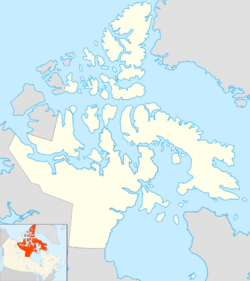Qikiqtarjuaq (Hudson Strait) facts for kids

Qikiqtarjuaq, Nunavut
|
|
| Geography | |
|---|---|
| Location | Hudson Strait |
| Coordinates | 62°41′12″N 070°36′09″W / 62.68667°N 70.60250°W |
| Archipelago | Canadian Arctic Archipelago |
| Area | 803 km2 (310 sq mi) |
| Administration | |
|
Canada
|
|
| Territory | Nunavut |
| Region | Qikiqtaaluk |
| Demographics | |
| Population | Uninhabited |
Qikiqtarjuaq (ᕿᑭᖅᑕᕐᔪᐊᖅ), also known as Big Island, is an island in Nunavut, Canada. It is a large island located in the cold waters of the Hudson Strait. This island is not home to any people, meaning it is completely uninhabited.
Qikiqtarjuaq is part of the Qikiqtaaluk Region in Nunavut. It is separated from Baffin Island, a much larger island, by a narrow stretch of water called White Strait. The closest town to Qikiqtarjuaq is Kimmirut, which is about 28 kilometers (17 miles) away.
Contents
About Qikiqtarjuaq Island
Qikiqtarjuaq is one of several islands in Nunavut that share a similar name. The name "Qikiqtarjuaq" means "big island" in Inuktitut, the language of the Inuit people. This particular Qikiqtarjuaq island covers an area of 803 square kilometers (310 square miles).
Location and Geography
Qikiqtarjuaq is found within the Canadian Arctic Archipelago. This is a huge group of islands in northern Canada. The island's location in the Hudson Strait means it is in a very cold, Arctic environment. The strait connects the Atlantic Ocean to Hudson Bay.
The landscape of Qikiqtarjuaq is typical of Arctic islands. It likely features rocky terrain, tundra vegetation, and possibly small lakes or ponds. These areas are often covered in snow and ice for much of the year.
Nearby Islands
There are other smaller islands close to Qikiqtarjuaq. These include Upirngiviaaluk and Rabbit Island. These islands are also part of the vast and remote Arctic landscape of Nunavut.
Life on Uninhabited Islands
Even though Qikiqtarjuaq has no human residents, it is still an important part of the Arctic ecosystem. Uninhabited islands like Qikiqtarjuaq can provide safe habitats for wildlife. Animals can live and raise their young without disturbance from people.
These islands are often visited by Arctic animals such as polar bears, seals, and various types of birds. They play a role in the migration patterns and feeding grounds for many species. Scientists sometimes visit these islands to study the environment and wildlife.
See also
 In Spanish: Isla Big (Kimmirut) para niños
In Spanish: Isla Big (Kimmirut) para niños



